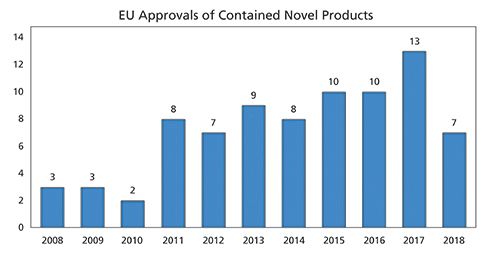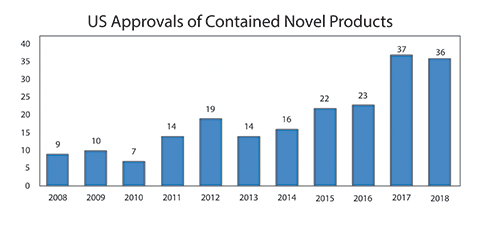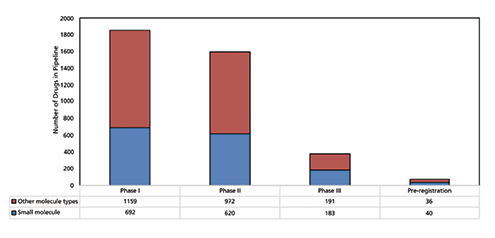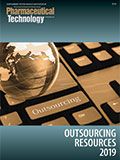HPAPI Capacity Challenges
Does the pharmaceutical industry have adequate access to contained equipment, facilities, and infrastructure for the manufacture of highly potent APIs?
DAVIDBAUTISTA - STOCK.ADOBE.COM

The pharmaceutical industry has been experiencing an increase in demand for drug products that contain highly potent APIs (HPAPIs), both in the United States and in Europe. According to Adam Bradbury, associate analyst at PharmSource, a GlobalData product, the number of innovative pharma product approvals requiring containment has been increasing since 2008 (see Figure 1). A majority of these products have been in the oncology and pain treatment areas. “The most commonly approved US product types requiring containment were (highest to lowest) controlled drugs, cytotoxics, steroids, immunosuppressants, kinase inhibitors, and nucleotides, which is indicative that many of these treatments are for oncology or pain relief,” says Bradbury.
Maurits Janssen, head of Commercial Development, API Development & Manufacturing, Lonza Pharma & Biotech, agrees. “We are witnessing a rise in the importance of drugs that include one or more HPAPI component. These molecules are useful in treating cancer, diabetes, autoimmune diseases, and other indications, and pharma and biotech companies are taking notice and incorporating them into innovative therapies.”
Figure 1: Number of innovative pharma product approvals in the European Union and United States from 2008 2018.

Figure 1: Number of innovative pharma product approvals in the European Union and United States from 2008-2018. (Figures courtesy of Global Data)

GlobalData’s Drugs by Manufacturer database reports that 532 novel approved drugs approved in the US and the EU require containment. “There is a tendency for both high potency drugs’ API and dose manufacture to be outsourced rather than manufactured in-house, although some of these products will also be dual sourced (both manufactured in-house and outsourced),” says Bradbury.
GlobalData’s research supports that statement; API manufacturing is outsourced for 255 of those drugs; 317 drug products are produced by contract manufacturers. In-house production is used for 201 highly potent drug substances and 295 HPAPI-based drug products.
Approximately 60% of HPAPIs in development are for oncology drugs (see Figure 2), which, according to Bradbury, points to an increase in demand for HPAPI manufacturing capacity. Because HPAPIs have special requirements for handling and containment, those companies looking to outsource HPAPI production may encounter challenges locating a contract development and manufacturing organization (CDMO) to develop and manufacture these hazardous materials.
Figure 2: Oncology drugs in development. (Figure courtesy of Global Data)

Projecting capacity supply and demand
“There is sufficient capacity in the market but obtaining additional capacity to boost business growth via acquisition is not economical for most pharma and biotech companies and CDMOs,” says Janssen. “Many customers we work with developing HPAPI products are small or emerging biotech companies, which have developed an excellent product but don’t have production capabilities or assets in-house. What they value is access to flexible and scalable manufacturing assets that can serve their specific needs-extending from drug substance into drug product technologies, in an integrated manner-and hopefully grow with them seamlessly toward commercial production as there is increased demand for their product.”
During a presentation at the 2019 CPhI North America conference, however, audience members indicated current capacity may not be able to handle future demand. Anil Kane, executive director, global science and technology, pharmaceutical development services, at Thermo Fisher Scientific, suggests it might be all about planning (see Sidebar). “In my opinion, there is capacity [for development-scale and commercial-scale], but of course the infrastructure is limited, so it’s all about planning and scheduling,” says Kane.
According to Bradbury, there are 209 facilities across 148 companies in the US that offer containment capabilities. Europe has 403 facilities in 247 companies. “All of the evidence indicates that containment facilities are in high demand, and this trend will increase as the oncology pipeline continues to flourish,” says Bradbury. “CDMOs with containment capabilities are likely to be at an advantage compared to those without, as the number of marketed HPAPIs tends to increase over time as more HPAPI drugs gain approval,” says Bradbury.
To meet this demand, CDMOs may need to tailor services and facilities for specific clients and add facilities, equipment, and services to meet demand. These organizations may also have to balance manufacture of HPAPIs alongside non-potent APIs. Being flexible and tailoring manufacturing techniques, equipment, and containment options to a molecule’s properties and synthesis requirements may result in increased safety, a reduction in cost, and enhanced capacity for HPAPIs (1).
Expansion and investment
Contract manufacturing organizations (CMOs) that offer containment capabilities have an advantage over those that do not and may also see an increase in revenue, Bradbury says. “There is a direct correlation between CMOs that offer HPAPI capabilities and generation of high revenues; as those facilities/capabilities are very expensive to build or acquire, only the largest CMOs can afford them, allowing those CMOs to take on projects that others cannot, therefore boosting revenues,” says Bradbury. Many CDMOs and CMOs, as a result of the increase in demand, have been making investments in the HPAPI area.
“As we continue working with customers to develop and commercialize these medicines, we are always looking to enhance and expand our capabilities and manufacturing capacity to continue to meet their needs,” says Janssen. Lonza announced on June 13, 2019 plans to add two production lines in an expansion of the company’s HPAPI capacity at its Visp, Switzerland site (2), which houses the company’s Center of Excellence for HPAPI Manufacturing.
The announced investment adds two 4-m3-scale, multi-purpose lines to the company’s existing capabilities for lab- to large commercial-scale HPAPI production. The new lines are expected to be online by July 2020. Janssen states that a long-term manufacturing agreement Lonza reached with AstraZeneca was one of the reasons for the investment. In addition, he states, the expansion allows further improvement of flexibility in existing production lines, to reduce time-to-market and accelerate approval timelines for partners.
Another expansion Lonza made at the Visp facility took place in October 2018. The company built HPAPI capacity for the specific support of antibody-drug conjugate (ADC) payload manufacturing (3). “We are seeing an increase in projects in the highly potent API space, including ADCs, and we anticipate that additional capacity at larger scales will be necessary in the near future. This expansion offers companies a seamless integration to our ADC development and manufacturing suites in Visp, that from 2020 onwards will be the first site worldwide where all components to this type of product (i.e., antibody, payload, and conjugation to final product) can be served. We are always seeking ways to better serve our customers of all sizes and help bring innovative life-saving drugs to market,” says Janssen.
On June 20, 2019, CDMO Piramal Pharma Solutions announced the opening of a new wing at its Riverview, MI, site, into which the company has invested $10 million to upgrade (4). The new wing will produce HPAPIs with low occupational exposure limits (OELs).
The upgrade includes a new quality control (QC)/analytical lab and two kilo-labs in addition to a doubling of the office space to support growth at the Riverview site. To date, the site has had “the containment capability and engineering controls to safely handle HPAPIs with OELs down to 1mcg/m3, at scales ranging from grams to ~250 kilos,” according to the company. The new wing, with its two kilo-labs and QC/analytical lab, strengthens the company’s position in this area. The new wing is designed with “the required engineering controls and containment solutions to handle HPAPIs with OELs <1mcg/m3 and as low as ~20ng/m3.” Materials will be produced in this new wing at kilo-lab scales; and amounts of <5 kilos can also be produced.
“This new, enhanced capability opens the site up to a new base of customers, including the antibody-drug conjugate market. We are equipped to offer ADC customers a seamless end-to-end solution, since we can develop the HPAPI payloads and linkers here in Riverview, send them to our site in Scotland for the antibody conjugation, then back to our Lexington, KY, site for sterile fill/finish,” added Vince Ammoscato, vice-president and Riverview site head, in the press release.
In April 2019, Cambrex completed construction of a $24-million HPAPI manufacturing facility in Charles City, IA (5). “The production area will operate to an OEL down to 0.1µg/m3 and contain four reactors ranging from 200- to 1000-gallon capacity,” according to the company. The facility will be capable of manufacturing batch sizes up to 300 kg.
“Across our sites, Cambrex has a strong reputation in the handling and supply of potent molecules, and this investment allows us to increase the capacity we can offer our customers,” said John Andrews, vice-president, operations and site director, Cambrex Charles City, in a press release. “We have seen an increased number of molecules in the clinical pipeline being designated as potent and highly potent, so having the flexibility within our manufacturing network to scale up with existing customers as projects progress, as well as accommodate new projects, is crucial to meet those market needs.”
Conclusion
It’s apparent that the contract manufacturing industry is recognizing the increased demand for HPAPI containment capabilities, and companies are making investments and adjusting their services to meet that demand. As the pharmaceutical industry continues to develop complex treatments requiring complex ingredients, the industry will soon know if these adjustments are enough.
References
1. J. Pavlovich, “Classifying Potent and Highly Potent Molecules,” Supplement to Pharmaceutical Technology, s18–s20, s33 (August 1, 2018).
2. Lonza, “Lonza to Expand HPAPI Development and Manufacturing Capacity,” Press Release, June 13, 2019.
3. Lonza, “Lonza Expands HPAPI Development and Manufacturing Capacity for ADC Payloads,” Press Release, October 8, 2018.
4. Piramal Pharma Solutions, “Piramal Pharma Solutions Invests $10 million USD to Expand its High Potency API Capability in its Riverview Facility in US,” Press Release, June 20, 2019.
5. Cambrex, “Cambrex Completes Highly Potent API Manufacturing Facility at Charles City, IA,” Press Release, April 10, 2019.
Article Details
Pharmaceutical Technology
Supplement: Outsourcing Resources
August 2019
Pages: s6–s10
Citation
When referring to this article, please cite it as S. Haigney, “HPAPI Capacity Challenges," Pharmaceutical Technology Outsourcing Resources Supplement (August 2019).
